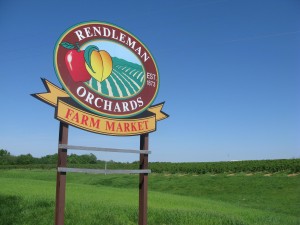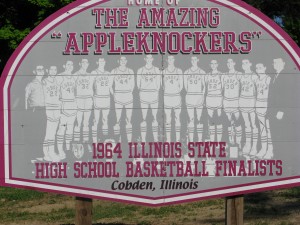Owl Creek Vineyard Eyes Southern Illinois Apples
The old Niagara vines, planted in 1980 by Owl Creek Vineyard founder and Midwest wine pioneer Ted Wichmann, still produce wine in Southern Illinois’ first post Prohibition vineyard. Owl Creek’s current owner, Brad Genung, is carrying on the pioneering tradition as he develops the first hand crafted hard ciders on the Shawnee Hills Wine Trail using local apples as the raw material.
The new ciders, which will be released early in 2013, are an extension of Genung’s wine making philosophy. “Our wines are mostly semi dry in the Loire Valley style and that’s also the crisp and delicate personality our ciders will have,” he said. “Cider making is a lot like wine making; everything we do is about making the characteristics of the fruit pop through.”
Genung said that Owl Creek is the first Shawnee Hills winery to make cider from local apples. As with any experimental venture, he said there is a process of trial and error. “Pressing grapes to make wine is relatively easy because a grape is like a bag filled with juice.” Genung said. “But an apple is more like a sponge filled with juice. We’re the first to crush many types of apples and some varieties don’t produce quality juice.” According to Genung, the popular grocery story varietal Red Delicious does not work well for cider.
One apple that Genung believes can make good cider is the Granny Smith. “Granny Smith is the Vignoles of apples,” Genung said, referring to the popular regional grape varietal known for its citrus character. Interestingly, a test batch of Owl Creek Granny Smith cider had acids that were similar to a late harvest Riesling. (TA of .96 grams per 100 ml and pH of 3.14.) Genung said the brix (a measure of sugar content) of a ripe apple is around 15 degrees, which is similar to the ripe Concord and Niagara grapes that are used in the Midwest to make both juice and wine.
 Apples have been grown commercially in Southern Illinois since the mid 1800’s. Rendleman Orchards, from which Genung sources apples, has been operated continuously by the same family since 1873. While Genung will not divulge the apple varieties in his ciders, there are many heirloom varieties produced at area orchards with diverse flavor characteristics and colorful names like Arkansas Black, Sopsy Wine and Ozark Gold.
Apples have been grown commercially in Southern Illinois since the mid 1800’s. Rendleman Orchards, from which Genung sources apples, has been operated continuously by the same family since 1873. While Genung will not divulge the apple varieties in his ciders, there are many heirloom varieties produced at area orchards with diverse flavor characteristics and colorful names like Arkansas Black, Sopsy Wine and Ozark Gold.
Blending apples is the one key to making cider, Genung said. To achieve the right blends, Genung and his staff conduct structured test batch tastings seeking the flavor characteristics that will produce a beverage with character and complexity.
“There’s as much complexity in apples as there is in grapes,” Genung said. “Our ciders will be made from as many as 11 apple varieties and all are local. After fermentation, some apples produce ciders with cinnamon notes while others have a citrus nose. Cider making is similar in many ways to aromatic winemaking.”
Drawing another connection between wine and hard ciders, Genung noted, “Most people correctly think of malic acid when they think of apple taste and chemistry, but there are actually tannins in apples, just like there are in grapes.”
Genung favors a slow, cold fermentation for cider making. Cold fermentation is normally used by winemakers when the goal is a light mouth feel and the crispness that is often associated with Pinot Gris. Grape yeasts do not work for cider, so Genung said that he is currently experimenting to find the proper neutral yeast strains that will provide the desired flavor profile.
Another area where cider making differs for wine making is stabilization. Genung said common methods of countering physical and microbial changes in bottled wine- cold stabilization, sterile filtering and sulfur dioxide- would change the flavor of cider. So to make sure cider is stable, it is heat pasteurized to produce a beverage that has no added preservatives.
Aside from a passion for hard ciders, Genung also has business reasons for launching ciders. “The cider segment is growing rapidly and it makes sense as an extension to the wine business which will always be a primary focus at Owl Creek.”
The seasonality of cider also makes it attractive from a cash flow and inventory perspective. “The main season for cider is summer, which is the opposite of the prime wine drinking months during the fall and winter holidays,” Genung said.
 Because the cider will be sold in 12 ounce six-pack bottles, Genung thinks that there is a year round retail market. Owl Creek cider will have a different brand name, Appleknocker Cider, the name of the mascot for nearby Cobden High School. (In 1964, the small town Appleknockers played in the Illinois state basketball championship, an accomplishment that is commemorated with a large sign as one enters town.)
Because the cider will be sold in 12 ounce six-pack bottles, Genung thinks that there is a year round retail market. Owl Creek cider will have a different brand name, Appleknocker Cider, the name of the mascot for nearby Cobden High School. (In 1964, the small town Appleknockers played in the Illinois state basketball championship, an accomplishment that is commemorated with a large sign as one enters town.)
Genung said that lighter alcohol ciders (about 7% alcohol) should appeal to a different customer than the traditional wine drinker. He also predicts that using all local apples will attract members of the growing local foods movement in Southern Illinois. “Owl Creek is now as much a part of the local food community as the local wine scene,” he said.
Genung took over wine production from Wichmann in 2005 when Owl Creek was producing 3,000 gallons per year. Current production is 12,000 gallons of wine each year. Genung recognizes that in order to keep growing in Southern Illinois where the number of wineries has increased exponentially in the past ten years, he needs to add new products and expand his facilities.
Once cider production is up and running, Genung projects total volume of 30,000 gallons of wine and cider per year. An addition was completed last fall to handle cider production and a second tasting room is currently under construction for the upcoming season.
[wp_geo_map]


